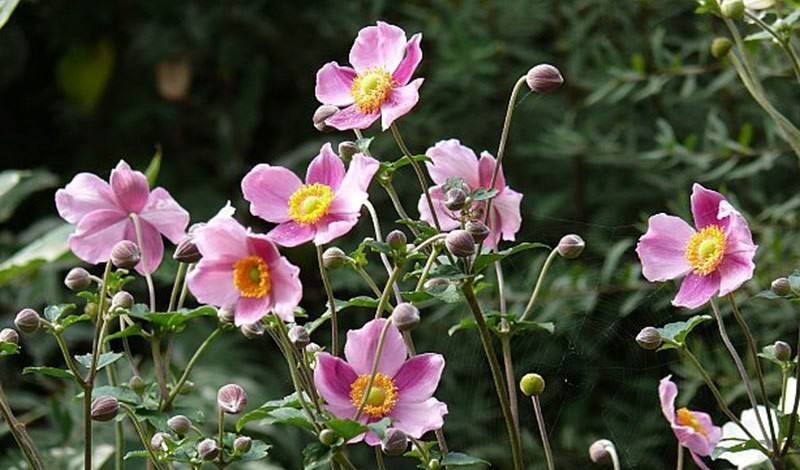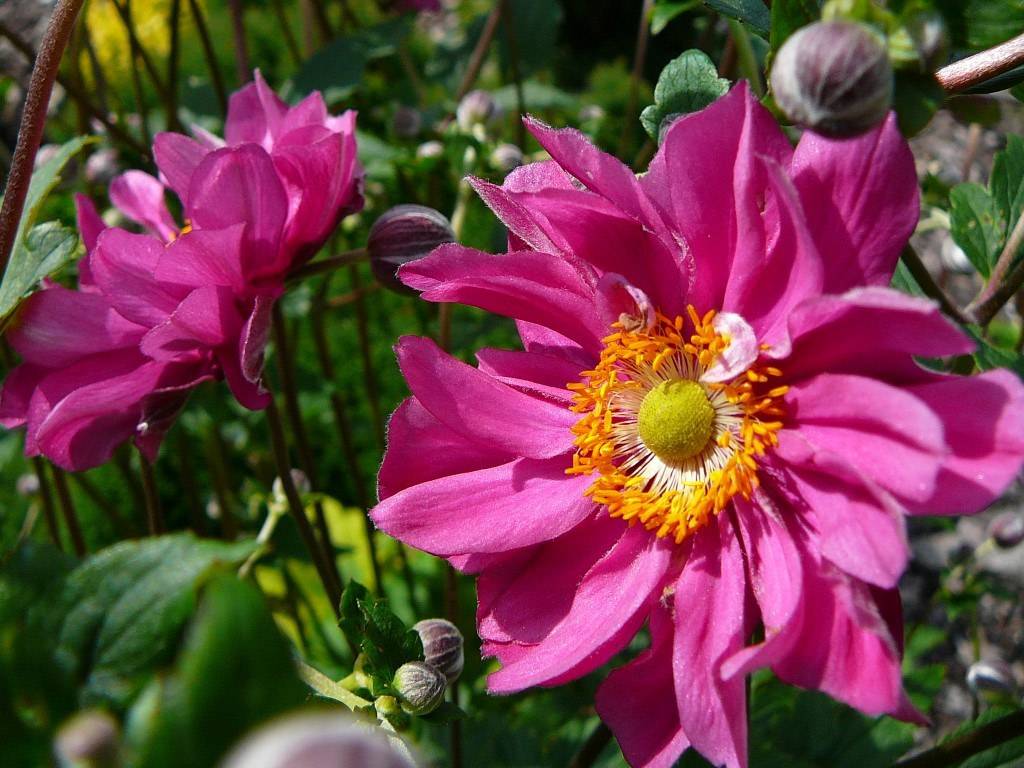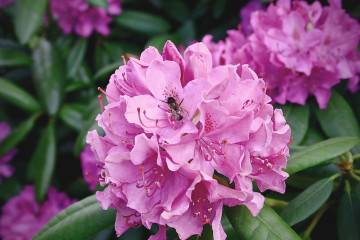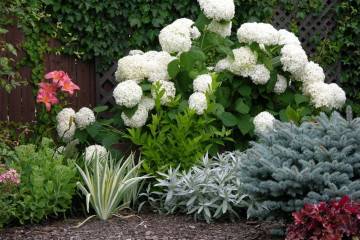Japanese anemone
Content:
A beautiful perennial herb with large and bright flowers - Japanese anemone belongs to the genus Anemone of the Buttercup family. In gardens, the flower is grown everywhere, since many cultivated species are distinguished by good winter hardiness. At the same time, flower lovers often do not even suspect what this plant is actually called.
Japanese anemone or Japanese anemone - features of planting and care in the open field
The homeland of this plant is Japan, therefore it is most adapted to the climate of this country. The gardener has to take this point into account when choosing a planting site. In Russia, anemones can be found everywhere, even in Siberia, where they are sheltered for the winter or dug up and stored in a cool dry place until spring.
It is very easy to care for the plantings, because they only need watering. But for prevention, treatments for diseases and pests are carried out at the end of spring. For most varieties, the flowering time is autumn, although hybrids can bloom in summer.
The use of Japanese anemones in landscape design
The plant is tall, so companions in the flower garden are selected according to their height. Usually anemones are planted along the perimeter of arbors, next to fences, and various outbuildings. This is a good decision, because it is desirable for delicate flowers to provide protection from strong winds.
Hostas, conifers, roses can be recommended as companions requiring similar growing conditions. A composition of several varieties of anemone looks beautiful. Flower heads fluttering in the breeze look very romantic and touching.
Pests of anemones and plant diseases
Anemones suffer most from fungal diseases. However, this usually happens in a thickened planting, a single plant is very rarely infested. If a group planting of flowers is planned, then it is recommended to carry out preventive fungicide treatment when planting seedlings in open ground.
The foliage can be eaten by caterpillars and slugs. If there is no desire to use chemical control agents, then it is worth adding to the mulch in the garden:
- eggshells,
- needles,
- ash,
- hot peppers.
Insecticides are most effective for caterpillars. If traces of nematode invasion are found, then Nematocide treatment will be required. Instead, you can use repellent plants: marigolds, calendula, nasturtium - they need to be planted nearby.
Shelter anemones for the winter
Japanese anemones are rhizome plants. They do not need digging for the winter. In the Middle Lane, an ordinary shelter is quite enough.
The soil is sprinkled with a layer of mulch made from peat, sawdust, fallen leaves, 5-7 cm thick. If the temperature is expected to drop below -30 ° C, then you can additionally cover it with spruce branches, or use agrotextile.
Japanese autumn anemone
The description says that autumn anemones are distinguished from other varieties by their high growth - up to 1.5 m.A typical representative is the September Charm variety (Anemone hupehensis September Charm) up to 120 cm high with pink flowers up to 8 cm in diameter.The buds are collected in loose umbrellas up to 10-15 pieces each.
The rhizome is creeping, the leaf is large pinnately dissected. The flower looks like a chamomile, but it can also be double. The petals are painted in all shades of white and pink, and the core is salad or yellow. In hybrid varieties, you can find purple and crimson flowers.
At the same time, the autumn anemone is inferior to the crown, more modest palette of colors. It is in the seeming simplicity of its flowers that gardeners find a special charm.
But gardeners believe that these varieties still have noticeable differences. The autumn leaf has a grayish tint and more modest sizes of the plant as a whole and its flowers. However, even on sale, you can find confusion in the names.
Anemone Hubei - features of planting and care in the open field
This autumn-flowering species has a lettuce-colored leaf with a reddish border around the edge, reminiscent of curly varieties of parsley. Looks very impressive in combination with pink flowers up to 8 cm in diameter. Duration of flowering - up to 40 days from the end of August.
This Japanese anemone prefers sunny areas. It is quite possible to plant in an open space, if there is an obstacle not too far away from the wind. It is even better if the clearing is shaded at noon. The main purpose of shading is to protect the soil from excess evaporation, as anemones love moist soil. As a last resort, it will help prevent the mulch layer from drying out.
This variety does not tolerate severe frosts (below -25 ° C), therefore, the ground part is cut off after wilting, and the rhizomes are dug up for the winter and stored in the same way as the bulbs - in a dry and cool place (about +4 ° C). If the winter in this region is milder, then you can not dig out, but simply cover the beds for the winter.
Japanese Anemone Pamina
Large-flowered variety with bright pink semi-double flowers with a yellow heart. Plant height can reach 70-80 cm.
Usually the bushes bloom at the end of August and bloom throughout September, until the first autumn frosts come, after which the ground part rapidly withers. Unlike other anemones, this species tolerates frosts only up to -29 ° C. But it is highly resistant to disease.
The preferred breeding method is by dividing the rhizome, which grows rather quickly. If the seed method is chosen, it is important to consider that the seeds require a mandatory 6-week stratification. When sown in open ground, seedlings will appear at the end of May. Prefers fertile loose soil and partial shade.
Anemone Pretty Lady Julia
Today one of the newest varieties of Hubain anemones. It blooms in large semi-double bright lilac flowers up to 5-6 cm in diameter, having a lemon-yellow or lettuce core. Blooming at the end of August, it continues to bloom until frost. The leaf is slightly dissected, light green, with jagged edges. Compact bushes keep their shape very well.
Pretty Lady Julia is suitable for planting in a flower garden, looks great both in group compositions and as a single plant. The variety Prekoks (Anemone Hupehensis Praecox) is very similar to it, which grows up to 70 cm in height and is distinguished by a slightly more saturated tone of corollas.
Prefers semi-shaded areas. The bush is formed up to 50 cm in height and width. It tolerates a winter temperature drop down to -28 ° С. Prefers moderately moist, humus-rich, well-drained soils.
In extreme heat above +30 ° C, the shoots can wilt. If the summer is expected to be hotter at the planting site, then you should choose a shaded place for planting, and watering should be carried out immediately, as soon as the soil dries slightly.Better yet, provide a layer of mulch around the bushes about 5 cm thick.
Anemone Prince Henry
Herbaceous perennial reaching a height of 80 cm. The dissected dark green leaves form a lush basal rosette. Flowers have a characteristic small curl of leaves on a strong long stem. Semi-double corollas of 20 petals.
Flowers are solitary or form an umbrella. Usually, the color of the petals is rich pink, but depending on the light, it can deviate towards cherry or lilac. This anemone variety blooms at the end of August and, under favorable weather conditions, pleases with elegant corollas for 6 weeks in a row.
Growing Japanese anemones is not difficult, and even a beginner will succeed if he gets an idea to decorate his plot with such flowers. Before the bushes bloom, they look very beautiful, thanks to their exquisite openwork foliage. Experienced flower growers practice mixed plantings of anemone that bloom at different times.























